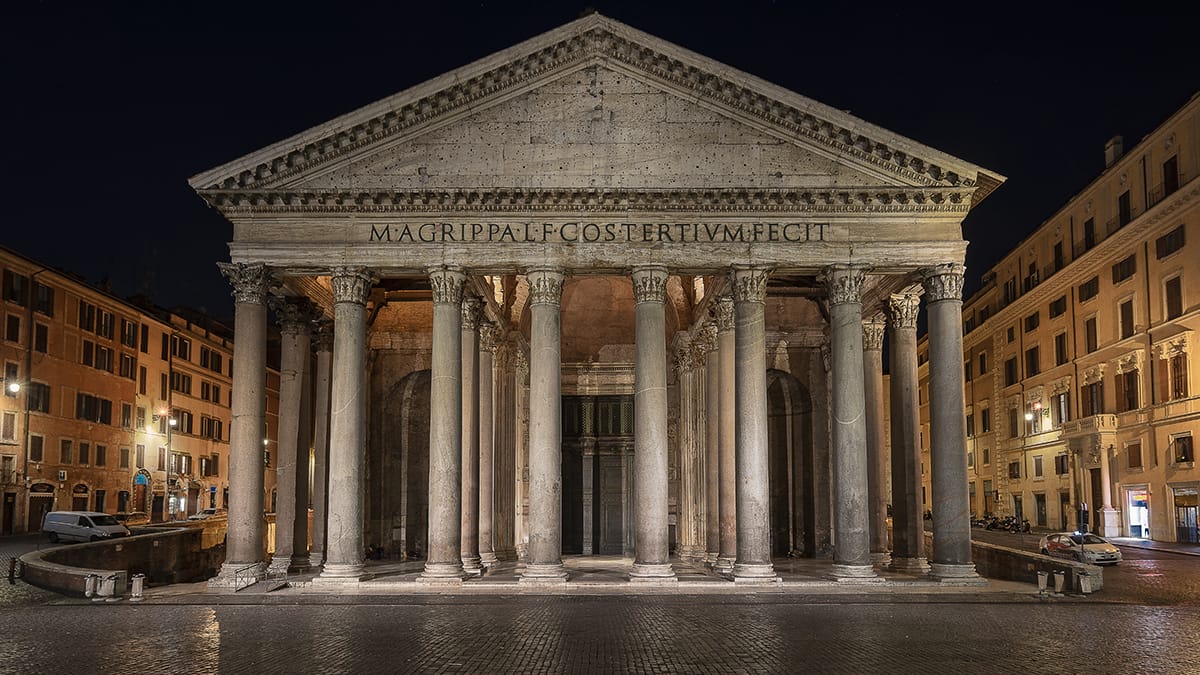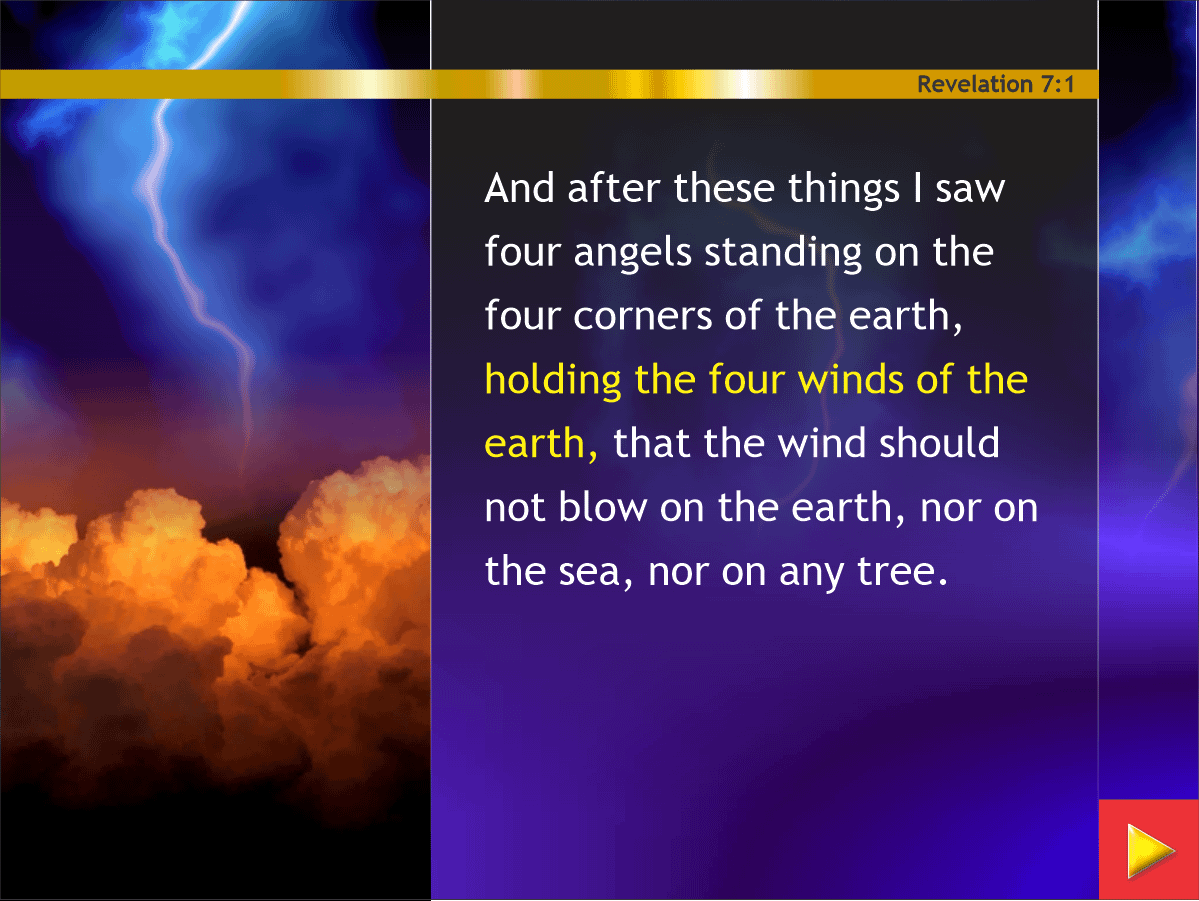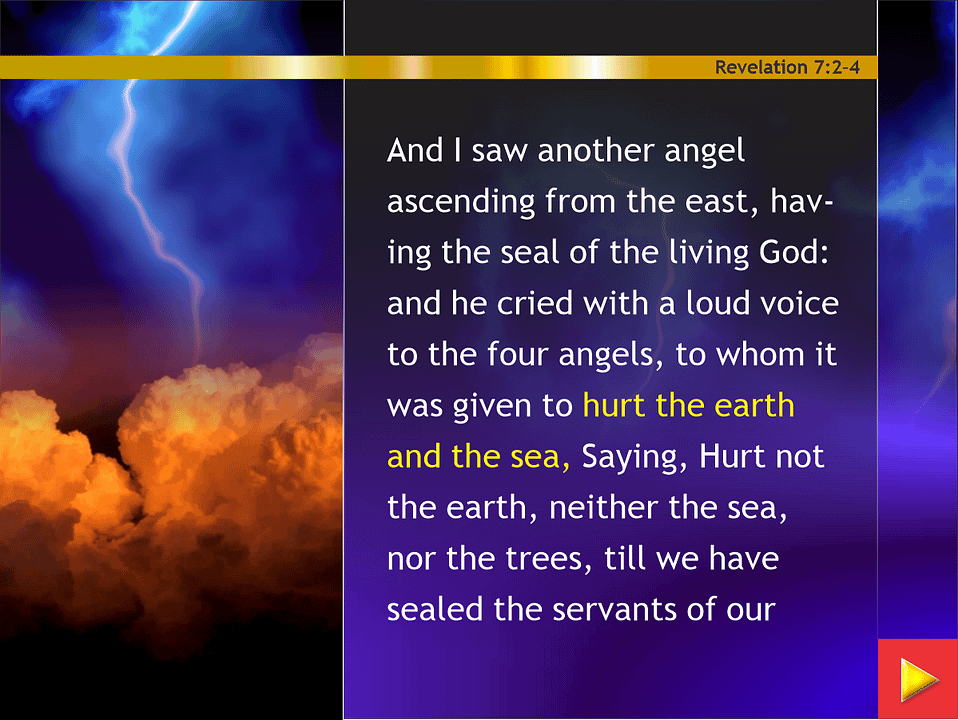Prophecy
Revelation
The Sixth Seal – Part Two
True and false Christianity
The 144,000 and the great multitude
And I heard the number of them which were sealed: and there were sealed an hundred and forty and four thousand of all the tribes of the children of Israel.
With the fall of paganism, Christianity became the religion of the empire. But the change meant many people converted only out of political expediency. As a result, nominal Christianity became corrupted, and eventually took on many of the old pagan forms of worship. Idolatry, and the worship of dead saints and Mary, became established. Baptism in water replaced baptism with the Holy Spirit as the seal of salvation. During this time a separation between the true worshippers and the false nominal majority began to take place. The true spiritfilled church receded to the background of history.



The storm was to be held back for a time as a separation took place within the “tribes of the children of Israel”. Out of each tribe a certain number (12,000) were to be sealed. This was not the total number of each tribe, but a much smaller number sealed “out of” each tribe. (See the discussion in the extracts at the bottom of this page.)
Revelation 7:4–5 (Amplified Version)
4 And [then] I heard how many were sealed (marked) out of every tribe of the sons of Israel: there were 144,000.
5 Twelve thousand were sealed (marked) out of the tribe of Judah, 12,000 of the tribe of Reuben, 12,000 of the tribe of Gad,
The “seal of God” refers to the Holy Spirit.
Ephesians 1:13-14
13 In whom ye also trusted, after that ye heard the word of truth, the gospel of your salvation: in whom also after that ye believed, ye were sealed with that holy Spirit of promise,
14 Which is the earnest of our inheritance until the redemption of the purchased possession, unto the praise of his glory.
2 Corinthians 1:21-22
21 Now he which stablisheth us with you in Christ, and hath anointed us, is God;
22 Who hath also sealed us, and given the earnest of the Spirit in our hearts.
Ephesians 4:30
30 And grieve not the holy Spirit of God, whereby ye are sealed unto the day of redemption.
The numbers are symbolic, and correspond with the similar use of “twelve”, “twelve thousand”, and a “hundred and forty and four” in relation to the New Jerusalem, the bride of Christ, in Revelation 21.
Just as the symbols of the temple and temple furniture, such as the candlesticks, and altars (see the Fifth Seal), have reference to the church in Revelation, so do the symbols of Jerusalem and the tribes of Israel (the names of the twelve tribes are also written upon the twelve gates of the New Jerusalem). But as “they are not all Israel, which are of Israel” (Romans 9:6), and “he is not a Jew, which is one outwardly … but he is a Jew, which is one inwardly; and circumcision is that of the heart, in the spirit” (Romans 2:28–29), so here a distinction is made between the broader “nominal” outward Christianity in history at this time, and the true Christianity. The tribe of Dan is omitted in the list here, likely because Dan represented idolatry in Israel from early times (Judges 18:30–31).
If both the numbers and the tribes are symbolic, they represent a small number of the genuine and faithful people of God sealed and separated out of a large number of those only professing to be the people of God – Christian in name only. Because this is what happened in history, and this paganised version of Christianity transformed into the second phase of Rome, it is to be expected that the prophecy would represent the fact.
The distinctions between visible “Christianity” and true Christianity are echoed again in the later era of the Reformation, symbolised in Revelation 10 and 11. There John is told to measure “the temple of God, and the altar, and them that worship therein”, or, measure the visible church and its worship. In that spiritual measurement, by the standard of the Word of God, a distinction and separation was to be made between the Holy Places (where only Israel was permitted), and the outer court of the Gentiles, which was left out, and not to be included within the measure or number. The temple there represented historical “Christianity”, but separated into what was in fact holy, and what was in fact, unholy – what was true and what was false.
It is in the same manner that the apostle Paul warns of “the man of sin” who was to be revealed – “he sitteth in the temple of God, setting himself forth as God” (2 Thessalonians 2:4). In Paul's epistles, the temple of God was the church, “the temple of the Holy Ghost”, and it was the visible church the “man of sin” would appear to be seated in, exalting himself over all others. The papacy has fulfilled this for approximately three-quarters of the New Testament era. But without the sealing and indwelling of the Holy Spirit, the part of the visible "temple" the papacy sits within is shown to be spiritually Gentile and not truly within the Holy Places.


In the nearly a century between Constantine and Theodosius the old pagan religions and gods had disappeared from the Roman Empire, ostensibly replaced by Christianity. The conversion was not real. The nominal Christian system that arose from this era was a corrupted mix of paganism and the truth, and the true church moved into the background of history.
The idolatry and paganism of Rome revived in a new and pseudo-Christian form, and would continue to dominate the ten kingdoms of Europe that were to arise out of the fall of the Western Roman Empire.

During the period between Constantine and Theodosius, and the rapid corruption of the visible church into a new form of paganism and idolatry, the Empire came more and more under pressure from the nations outside its borders. While Theodosius still lived, this Barbarian threat, which was to bring the Western Empire to an end, was held at bay. Gibbon likens it to a threatening tempest held back for a time on the frontiers, just as indicated in the prophecy. Henry Hallam, also, speaks of how the “fourth century set in storms”.
“If under the house of Constantine the Roman world suffered rather less from civil warfare or barbarous invasions than in the preceding age, yet every other cause of decline just enumerated prevailed with aggravated force; and the fourth century set in storms, sufficiently destructive in themselves, and ominous of those calamities which humbled the majesty of Rome at the commencement of the ensuing period, and overwhelmed the Western Empire in absolute and final ruin before its termination.”
View of the State of Europe during the Middle Ages, 1871
Henry Hallam

Here Gibbon likens the Barbarian stirring in the North (the direction from which comes cold weather and hail in the Northern Hemisphere) to the collecting of a dark cloud along the borders, ultimately bursting like a storm upon the empire. Appropriately, the opening of the Seventh Seal and the blowing of its First Trumpet brings the vision of a hail storm upon the land.
The first four Trumpet visions bring about the fall of the Western Roman Empire and its breaking up into the ten kingdoms of Europe. This was brought about by the invasion of other peoples – the Goths, Vandals, and Huns. The mingling of these peoples with the people of the Roman Empire corresponds to the change of the iron legs to the feet of iron mingled with clay in the prophecy of Nebuchadnezzar's image in the book of Daniel. It introduces a new and more dangerous phase of the power of Rome.

The 144,000 represent the true church on the earth. The symbolic number represents the people of God living at any particular moment throughout the New Testament era, those who are sealed with the Spirit of God, having their “Father's name written in their foreheads” (Revelation 14:1). They are those who are marked or called out from the great “falling away”, and are built upon the true foundation, which stands sure, and which has this seal, “The Lord knoweth them that are his. And, Let every one that nameth the name of Christ depart from iniquity” (2 Timothy 2:19). They are sealed, or known of God, and they have kept themselves from the iniquity of Rome. They are named of God, and their profession of the name of Christ is not false.
The vision of the sealing of the 144,000 out of Israel against the coming storm of hurt and destruction, echoes the vision in Ezekiel of the Lord marking out the righteous for salvation from the destruction of the wicked.
Ezekiel 9:1–6
1 He cried also in mine ears with a loud voice, saying, Cause them that have charge over the city to draw near, even every man with his destroying weapon in his hand.
2 And, behold, six men came from the way of the higher gate, which lieth toward the north, and every man a slaughter weapon in his hand; and one man among them was clothed with linen, with a writer's inkhorn by his side: and they went in, and stood beside the brasen altar.
3 And the glory of the God of Israel was gone up from the cherub, whereupon he was, to the threshold of the house. And he called to the man clothed with linen, which had the writer's inkhorn by his side;
4 And the LORD said unto him, Go through the midst of the city, through the midst of Jerusalem, and set a mark upon the foreheads of the men that sigh and that cry for all the abominations that be done in the midst thereof.
5 And to the others he said in mine hearing, Go ye after him through the city, and smite: let not your eye spare, neither have ye pity:
6 Slay utterly old and young, both maids, and little children, and women: but come not near any man upon whom is the mark; and begin at my sanctuary. Then they began at the ancient men which were before the house.
It also echoes the marking of the head and arms (lintel and side posts) of the door with the blood of the lamb in order that death might “pass over” the people of Israel in the final plague on Egypt.
Exodus 12:23
23 For the LORD will pass through to smite the Egyptians; and when he seeth the blood upon the lintel, and on the two side posts, the LORD will pass over the door, and will not suffer the destroyer to come in unto your houses to smite you.
These things will be seen to be in contrast to those who worshipped the Beast and spiritually “received his mark upon their foreheads, or in their hands” (symbolising the rendering of assent with the mind, or service with the hands, to his thoughts and deeds).












